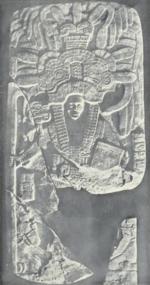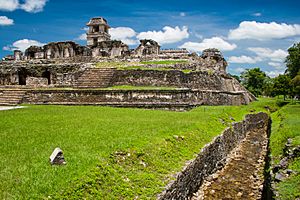Kʼinich Yoʼnal Ahk I facts for kids
Quick facts for kids Kʼinich Yoʼnal Ahk I |
|
|---|---|
| Ajaw | |

Kʼinich Yoʼnal Ahk I's portrait in Stela 26
|
|
| King of Piedras Negras | |
| Reign | 14 November 603 - 3 February 639 |
| Predecessor | Unknown |
| Successor | Itzam Kʼan Ahk I |
| Died | 3 February 639 Piedras Negras |
| Consort | Lady Bird Headdress |
| Issue | Itzam Kʼan Ahk I |
| Religion | Maya religion |
| Signature | |
Kʼinich Yoʼnal Ahk I (Mayan pronunciation: [kʼinitʃ joːnal ahk]) was an important leader, or ajaw, of Piedras Negras. This was an ancient Maya city in what is now Guatemala. He is also known as Ruler 1. He ruled during the Late Classic Period, from 603 to 639 AD.
Many believe he started a new line of kings in Piedras Negras. This happened after a time when previous rulers might not have been very strong. We don't know exactly how Kʼinich Yoʼnal Ahk I became king. But we do know he won several important wars against nearby cities like Palenque and Sak Tzʼiʼ. His son, Itzam Kʼan Ahk I, took over after him in 639 AD. Kʼinich Yoʼnal Ahk I left behind many important monuments. These include large stone carvings called stelae and a big temple known as Pyramid R-5.
Contents
Who Was Kʼinich Yoʼnal Ahk I?
Kʼinich Yoʼnal Ahk I was a powerful ajaw, or king, of Piedras Negras. He ruled in the 7th century AD. Experts who study the Maya, like Simon Martin and Nikolai Grube, believe his name means "Great-Sun ?-Turtle". The word kʼinich means "red-faced". It was a special title used by Maya rulers. It showed they believed they were "lords of the sun." Later kings of Piedras Negras, like Kʼinich Yoʼnal Ahk II and Yoʼnal Ahk III, also used this name.
Kʼinich Yoʼnal Ahk I became king on November 14, 603 AD. The exact details of how he came to power are not fully known. Some historians, Stephen D. Houston and Charles Golden, think he started a new ruling family in Piedras Negras. This might have happened after a difficult time for the previous leaders.
A New Start for Piedras Negras
When Kʼinich Yoʼnal Ahk I took power, he did something unusual. He removed or destroyed buildings and monuments that were linked to the old kings. This was probably a special ritual to show a fresh start. It was like he was cleaning the city of any reminders of the past rulers. This period of clearing out old structures focused on the western part of the city. We know it was a ritual because of clues left behind. These clues include offerings of pottery, jade, and small figures. After this, Kʼinich Yoʼnal Ahk I began building new structures in the southern part of the city.
Wars and Legacy
Kʼinich Yoʼnal Ahk I led his people in battles against other cities. He fought against Palenque, which was a main rival for Piedras Negras. He also fought against Sak Tzʼiʼ, a smaller city. In the war with Palenque, he captured an important leader named Chʼok Balam. In the war with Sak Tzʼiʼ, he captured another ruler named Kʼab Chan Teʼ.
Kʼinich Yoʼnal Ahk I died on February 3, 639 AD. He was likely buried in a large pyramid known as Pyramid R-5. His son, Itzam Kʼan Ahk I, became the next king. Itzam Kʼan Ahk I later honored his father's tomb in 658 AD.
Important Monuments
Kʼinich Yoʼnal Ahk I created many important monuments. These often became examples for future kings of Piedras Negras.
Stelae: Stone Carvings
Kʼinich Yoʼnal Ahk I built many stelae. These are tall, carved stone slabs. His first stela was Stela 25. It showed a new style called the "niche" style. In this style, the king is shown sitting in a small hollow. He sits on a fancy platform that looks like it's floating. This was meant to show that the king was lifted up, almost into the air.
On Stela 25, Kʼinich Yoʼnal Ahk I sits on a "jaguar cushion". A ladder with bloody footprints connects him to the ground. These footprints likely represent human sacrifice. Above the king, the sky is shown as a large canopy. Above that is a "great celestial bird," which was a symbol of the Maya god Itzamna.
Stela 26 was made in 628 AD. It shows the war with Palenque. This stela was special because it had carvings on more than one side. These carvings included important dedication texts. Stela 26 was placed in line with Stela 35, built by a later king, Itzam Kʼan Ahk II. This showed a connection and a sense of history between the rulers.
Stela 31 was made around 637 AD. It shows the war with Sak Tzʼiʼ. This stela was placed in front of Structures R-3 and R-4. These were places where many of Piedras Negras's oldest monuments stood. Stela 31 was also very tall, about 4.5 to 5 meters (15 to 16 feet) high. It had a special platform that made it easier to see.
Both Stela 26 and Stela 31 show a common theme for Kʼinich Yoʼnal Ahk I: the "warrior king." These carvings often show the king facing forward. He wears a large headdress with symbols of the "Teotihuacan War Serpent."
Pyramid R-5: A Royal Burial Site
Kʼinich Yoʼnal Ahk I was probably buried in the R-5 Pyramid. We know this mostly from Panel 4. This carving was made by his son, Itzam Kʼan Ahk I. The carving clearly says that the pyramid was the muk (burial place) of Kʼinich Yoʼnal Ahk I. It also says that Itzam Kʼan Ahk I either dedicated or ceremonially re-opened the pyramid.
Even with this evidence, no body has been found in the pyramid. The search was made difficult by things left behind by looters. Most of the pyramid was likely built after Kʼinich Yoʼnal Ahk I died. His son, Itzam Kʼan Ahk I, probably oversaw the construction. Itzam Kʼan Ahk I later placed six stelae at the base of the pyramid.
Images for kids



